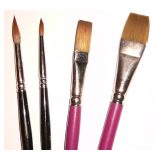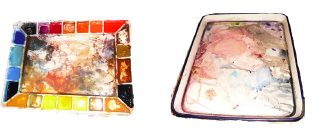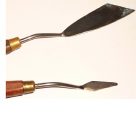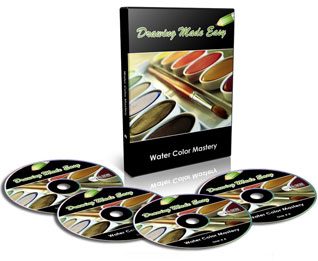The only absolute necessities for watercolor painting are paper, paint and water.
But there are better and worse choices to make when you are selecting materials.
If you are a beginner, you can use a cheaper watercolor paper because you’ll be throwing most of your work away.
Once you become more comfortable, however, you should upgrade to a higher quality cotton rag paper.
There are three texture surfaces available; hot pressed is smooth, cold pressed is a medium texture, and rough is highly textured. You can use a block or individual sheets.
If you use the latter, you’ll need to soak the paper for about ten minutes and then staple or tape it to a stiff backing such as 1/4 inch plywood or gator board.
For brushes, get a selection of three sizes of rounds and three flats. They should be listed as watercolor brushes, which are designed specially to perform well with water-based paint.
Never use your watercolor brushes for other mediums such as acrylic or oils. You should also invest in some stiffer brushes that can be used for lifting and blending color.
A small angled shader craft brush is a good choice, as are scrubber brushes (available at art stores).
Start with about ten or twelve colors of watercolor paint. Student grade is fine to begin with. There is no right or wrong, but don’t try painting with all of them at once. Begin with a few colors and build up gradually, or you’ll easily make mud.
Generally, it’s better to mix the colors you need than to use straight tube colors, so start with the primaries. To hold the paint, use a butcher’s tray or a palette with wells.
You paint with water just as much as with paint itself, so invest in a selection of water sprayers, both pump and trigger-style.
You’ll also need a bucket for holding water, tissues for blotting, and some tools for making textures.
Palette knives are good to have on hand, as are credit cards and needle tools (which are usually used for pottery).
Finally, it’s good to have some masking fluid for preserving small areas that need to be kept white.
A small pot or bottle should be enough to last for a long time. When working with masking fluid, make sure to only apply it to dry paper, otherwise it will
fuse into the fiber and be impossible to remove
Remove it when dry by rubbing it off with your (clean) finger.
With these simple step by step watercolor drawing lessons … you’ll be able to master water color paintings in record time. This is regardless of your previous experience.
With high definition videos and detailed PDF material on watercolor, you will have all the information you need to bring your watercolor paintings to life.






